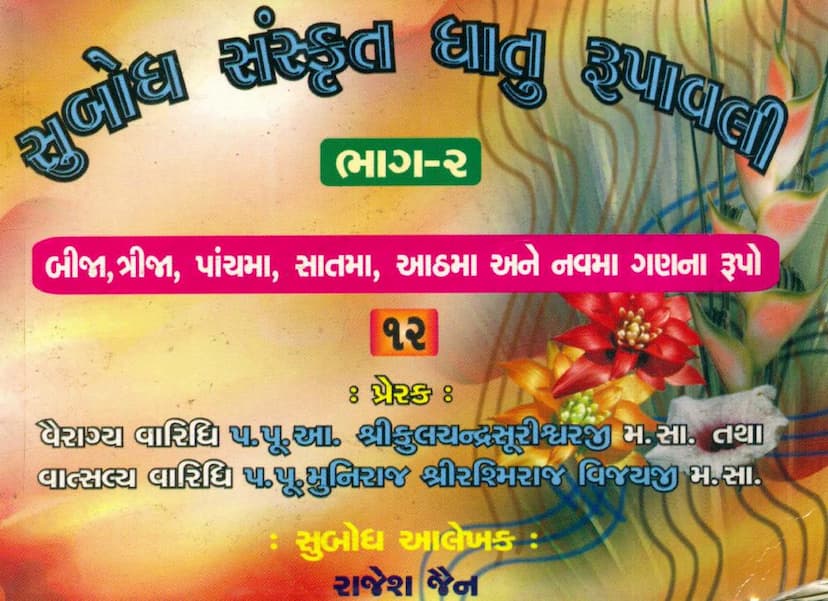Subodh Sanskrit Dhatu Rupavali Part 02
Added to library: September 2, 2025

Summary
Here's a comprehensive summary of the Jain text "Subodh Sanskrit Dhatu Rupavali Part 02":
This book, "Subodh Sanskrit Dhatu Rupavali Part 02," authored by Rajesh Jain and published by Tattvatrai Prakashan, is the second volume in a series dedicated to providing clear and accessible explanations of Sanskrit verb roots (dhatus) within the framework of Jain traditions and philosophy. It serves as a comprehensive guide for understanding Sanskrit grammar, particularly focusing on the conjugation of verb roots.
Key Features and Content:
- Focus on Specific Verb Classes: This volume specifically delves into the verb roots belonging to the second, third, fifth, seventh, eighth, and ninth classes (ganas) of Sanskrit verbs. This is a continuation from the first part, which likely covered other classes.
- Detailed Conjugation (Rupakhyana): The core of the book is the systematic presentation of the various forms (rupas) that these verb roots take in different tenses, moods, voices (active and passive), persons, and numbers. This process is referred to as "Rupakhyana."
- Coverage of Tenses and Moods: The book meticulously details the conjugations for:
- Present Tense (Vartaman Kal): Including both active (kartari) and passive (karmani) forms.
- Imperfect Past Tense (Hastana Bhutkal or Anadhana-apoorna Bhutkal): Again, covering active and passive voices.
- Imperative Mood (Ajnarth): For commands and requests, in both active and passive.
- Potential Mood (Vidhyarth): For expressing possibility, obligation, or desire, in both active and passive.
- Analysis of Verb Endings (Pratyaya): The book also explains the suffixes or endings (pratyayas) that are attached to the verb roots to form these different conjugations, including the "vikaran pratyayas" (augmenting suffixes) specific to certain verb classes.
- Inclusion of Participles (Kridanta): Beyond finite verb forms, the book covers various types of participles derived from these roots, such as:
- Present Active and Passive Participles (Vartaman Kartari and Vartaman Karmani Kridanta).
- Potential Participles (Vidhyarth Kridanta).
- Passive Past Participles (Karmani Bhutakridanta).
- Causal/Gerundive Participles (Hetvarth Kridanta).
- Adverbial Participles (Sambandhak Bhutakridanta).
- Structure and Organization: The book is organized into chapters, with a detailed index (Anukramanika) that lists the verb roots, their class, meaning, and the pages where their conjugations are explained. This aids in easy navigation and reference.
- Pedagogical Approach: The title "Subodh" (meaning "easy to understand" or "clear") suggests a pedagogical intention to make the complex subject of Sanskrit verb conjugation accessible. The inclusion of specific rules from "Subodh Sanskrit Mandiraḥ Pravesika" reinforces this.
- Jain Context: While primarily a Sanskrit grammar text, its publication by a Jain organization and its placement within a series of Jain educational materials imply that the examples and explanations might be tailored or contextualized within Jain teachings or vocabulary where applicable, though the core focus remains linguistic.
- Publication Details: Published by Tattvatrai Prakashan, with branches in Dholka and Unjha, Gujarat, India. The book was first published in VS 2059 (2004 CE) with a print run of 1000 copies.
In essence, "Subodh Sanskrit Dhatu Rupavali Part 02" is a scholarly and practical resource designed to equip students and scholars of Sanskrit, particularly within the Jain tradition, with a thorough understanding of how Sanskrit verbs from specific classes are formed and conjugated. It provides a systematic and detailed grammatical breakdown, making it a valuable tool for linguistic study and textual interpretation.